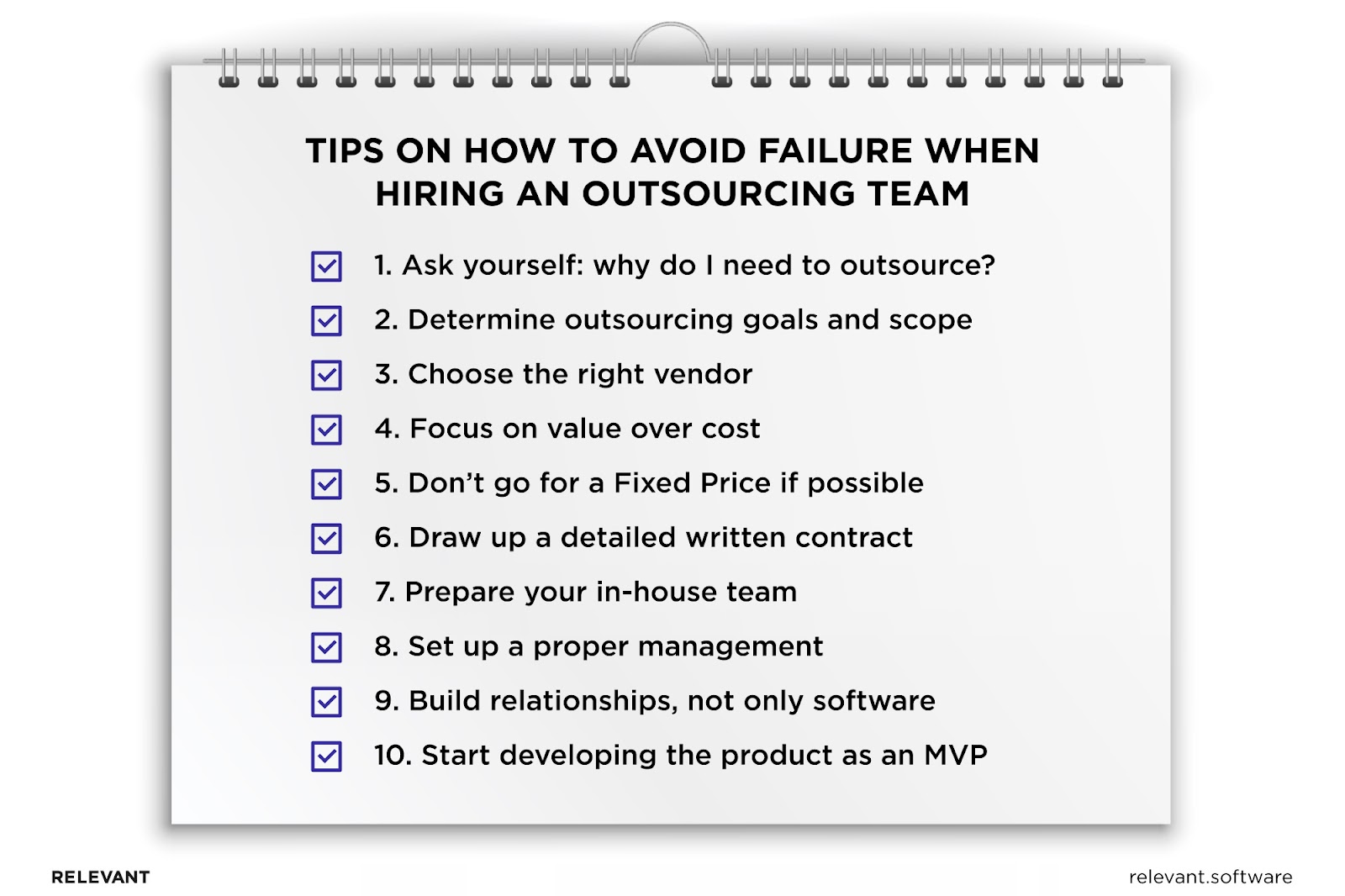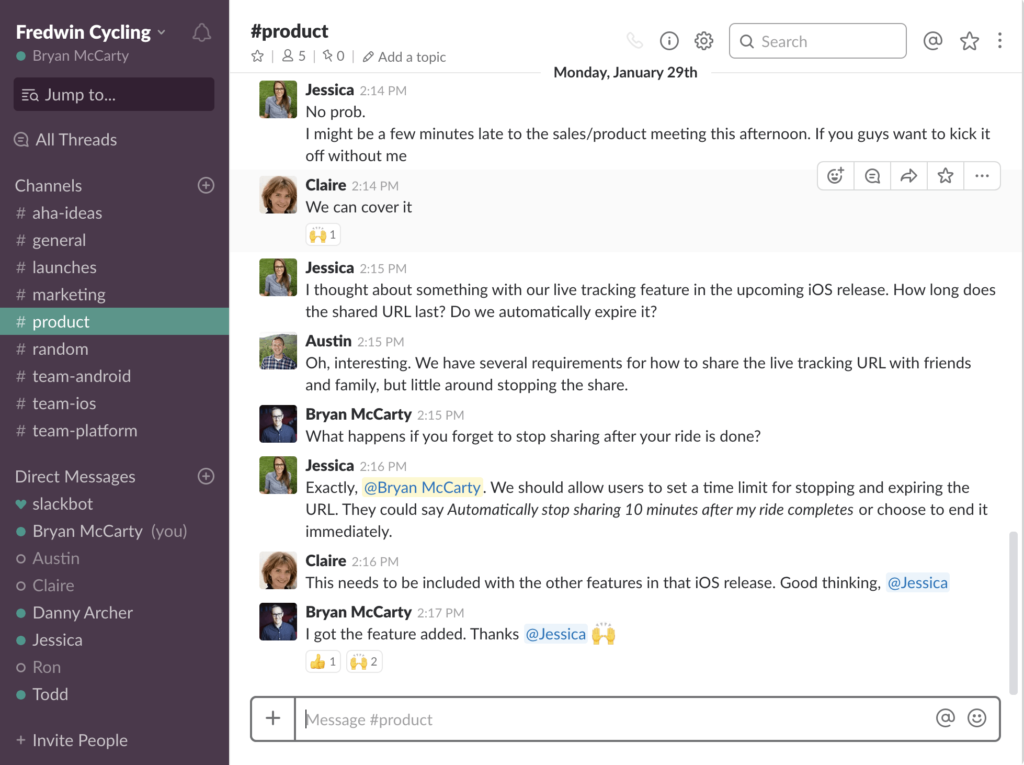10 Tips on How to Avoid IT Outsourcing Failures in 2025
Updated: June 4, 2025
There is no longer any doubt that outsourcing has become a standard practice for businesses worldwide, providing a cost-effective solution for software development projects. By outsourcing, you can save time and resources and focus on your core competencies while achieving high-quality results. What other choice do you have to succeed?
But as with any business strategy, IT outsourcing comes with its own set of failures and potential risks. The good news is that these risks can be managed with careful planning and preparation, along with a clear understanding of the common pitfalls and their causes.

We provide companies with senior tech talent and product development expertise to build world-class software. Let's talk about how we can help you.
Contact usIf you’re looking to outsource this year, we invite you to read our article on the reasons behind outsourcing failures and how to avoid them, with real-world examples to learn from. Let’s dive in and ensure your outsourcing strategy will be a success.
Table of Contents
Why Do Companies Outsource?
The reasons why companies outsource are diverse and numerous. We will only describe some since our topic is not about that. So, companies outsource development when:
- The expertise or tech knowledge being outsourced cannot be obtained or accomplished in-house due to various factors such as cost, insufficient skill set, and time constraints.
- Your software development activity requires quality processes, methods, and techniques that you cannot achieve internally.
- Developing software in-house yields minimum value and requires more management oversight than is warranted, and so on.
The cases mentioned above, along with many others, can be effectively solved through outsourcing. However, not all outsourcing projects turn out to be successful. What are the underlying reasons? Let’s look closer.

When Does Outsourcing Fail?
The statistics are alarming: 25-50% of outsourced projects fail or underperform, while 76% of companies face supplier management issues and hidden costs. Communication issues within providers affect 30% of companies, and 51% express dissatisfaction with performance. Ultimately, companies only save 26% on average, which could be better.
Are you discouraged by the high failure rates? Don’t be too quick to throw in the towel. Interestingly, many reasons for outsourcing failures do not stem from outsourcing companies. Rather, they can often be traced back to the client’s lack of familiarity with software development, outsourcing, and all these processes entail. By avoiding these common causes of failure we listed below, you can be sure your outsourcing journey will succeed.
- Lack of strategic objectives. Cost reduction should not be your only objective of outsourcing. Focusing solely on cost savings can lead to choosing the cheapest supplier, who may not deliver a successful outcome.
- Unclear requirements and expectations. Unrealistic expectations can be disguised as unwavering confidence, leading to over-promising and under-delivery. To prevent this, align your expectations with reality and communicate them to your outsourcing vendor.
- Insufficient understanding of risks. A lack of knowledge of potential risks in outsourcing projects can lead to complications and additional problems during the delivery phase.
- Inappropriate technology. You stick with outdated or inefficient technologies or are lured by the latest technologies that may not suit your project requirements. These missteps can lead to budget overruns and project release delays, jeopardizing the outsourcing partnership’s success.
- Poor knowledge transfer. Effective communication is vital for a smooth transition of requirements and processes to a remote team. Failure to do so can lead to disastrous results.
- Scope creep. At first, a scope creep can seem innocent enough. You ask to add a feature here or to expand a service there, and before you know it, your project scope grows beyond its original boundaries, and your team is stretched thin.
- Poor communication. You don’t establish a common working space to share ideas and collaborate on the tasks, which hinders the project’s progress.
- People factors. Retaining talent can challenge providers, leading to teams without loyalty or purpose. Disengaged teams can lose focus and contribute to project failure.
- Over-management or micromanagement. You may tend to over-manage, leading to frustration for the provider. Over time, this can damage the outsourcing relationship.
5 Examples Of Outsourcing Failures (key takeaways for businesses)
Only a fool learns from his own mistakes. The wise man learns from the mistakes of others! If you take a look at these five companies that decided to stop outsourcing, you can figure out what went wrong with their outsourcing efforts. By learning from their mistakes, you can use outsourcing more effectively and sidestep in making the same blunders.

Hertz and Accenture case
Hertz hired Accenture to redesign its website and mobile app, but the provider ignored scalability requirements and created a product that wasn’t applicable outside North America. As a result, Hertz filed a $32 million lawsuit against Accenture for supplying a substandard product.
Key takeaways: define expectations, document claims, and communicate constantly.
Queensland and IBM case
The Queensland Health Department contracted IBM to develop a payroll system for $6 million, but the costs escalated to $850 million, and the system never functioned correctly. The government tried to sue IBM, but the lawsuit was dismissed.
Key takeaways: determine outsourcing team capabilities, assess risks and cost estimates, and maintain realistic timelines.
Virgin Australia and Navitaire сase
Virgin Australia’s reservation system crashed when Navitaire failed to resolve critical issues promptly, causing financial and customer losses for both companies. This failure underscores the significance of technical expertise in IT outsourcing.
Key takeaways: consider logistics and time zones when choosing a vendor, and involve in-house developers to find solutions with outside specialists. Verify the competency of IT outsourcing companies to handle related issues.
Royal Bank of Scotland case
RBS’s botched software update paralyzed the system for weeks, denying millions of customers access to their accounts. As a result, The FCA fined the bank £42 million.
Key takeaways: define clear procedures and milestones and hold teams accountable.
The State of Texas and IBM case
The State of Texas hired IBM to consolidate data center operations, but after four years, IBM completed only 12% of the project, leading to backlogs and increased fees. Through this outsourcing failure, Texas suffered a loss of $863 million.
Key takeaways: stay up-to-date with project developments, create an official contract, and select the best contract model.
It’s necessary to remember that while outsourcing can present challenges, many success stories exist. Some of the most well-known and prosperous applications have been created through outsourcing. Fab, Skype, Github, Slack, AppSumo, Klout, and Branchout all started as outsourced projects. In addition, MYSQL, Opera, Pingar, Solix, Cloudmunch, Gliffy, Net2Text, Proximate Global Inc., Mailburn, and Mindspark are examples of outsourcing projects.
Undoubtedly, you want to be on the list of lucky ones, not losers. Then read on to find out how to approach outsourcing correctly and avoid issues that can ruin your experience.
Avoiding Potential Pitfalls When Hiring an Outsourcing Team: Tips to Follow
Now let’s move on to some practical advice on avoiding IT outsourcing failures. Don’t just rely on a checklist of tips, but rather use them as a starting point to develop a solid outsourcing strategy tailored to your specific needs and goals.

1. Ask yourself: why do I need to outsource?
Outsourcing has become increasingly popular among companies and can provide a significant competitive advantage. However, that does not necessarily imply that you should follow suit.
To determine if outsourcing is right, clearly define your objectives. What are you looking for? Development of new software products, cost savings, optimization of processes, or improvement of the quality of service? Then evaluate the resources you have available to start implementing your plans, such as manhours, skills, expertise, and budget for in-house developers.
Take the time to analyze and calculate your business metrics to determine if outsourcing will bring value to a task, project, or overall business. If you have enough resources available, consider keeping the work in-house. But if your employees are working more than 50 hours per week, it may be worth considering hiring a remote team.
It is worth noting that determining “when to outsource” is also crucial. For example, we do not recommend initiating outsourcing during a significant restructuring or change of senior management in your business.
2. Determine outsourcing goals and scope
To develop a successful outsourcing strategy, identify your long-term and short-term requirements and clearly envision the software development project you want to outsource. Write down responsibilities and expectations for your offshore team to avoid confusion and misunderstandings.
When choosing an outsourcing partner, be prepared to answer questions about your business and project goals. The right contractor will clarify as many requirements and expectations as possible before starting the project and will do their best to understand the unique nature of your project. The more information you provide, the better the vendor can estimate the size and cost of your project, align their processes with yours, and choose the most appropriate development methodology.
However, be cautious not to outsource activities unique to your business, core functions, or strategic initiatives. Retaining adequate in-house control over critical business functions is essential while leaving non-core competencies to outsourcing providers. Avoid outsourcing engagements without clear goals, a well-defined scope, and responsibilities, as they can result in confusion and poor performance.
3. Choose the right vendor
Choosing the right provider is crucial to establish an effective IT vendor management process. The ideal vendor comprehends your industry, shares your business objectives, and aligns with your culture. Therefore, we recommend you take the time to research potential overseas partners, as this could save you future troubles.
First, shortlist at least five outsourcing development companies, compare their IT outsourcing services, benefits, and company culture, and thoroughly analyze and shortlist them based on their expertise domains, previous projects, client feedback, and Clutch reviews. Next, arrange a meeting with the vendors’ representatives to gauge their commitment to the project, expertise in the field, and problem-solving abilities.
The vendor should possess the skill set and knowledge to accomplish their assigned tasks. Whether you’re outsourcing design, software development, or quality assurance, it’s advisable to review the work of potential vendors before finalizing any agreements. Additionally, don’t hesitate to ask for the CVs of individual developers or offshore team members to ensure you hire the best possible talent.
4. Focus on value over cost
Yes, outsourcing is often seen as a cost-saving solution, but it should not be the sole reason for considering it. Instead of approaching outsourcing as a way to save money, it should be viewed as a strategic tool to optimize your business operations. And given the above-ailing business examples, this should be done professionally.
When it comes to outsourcing vendor rates, they often reflect skills, experience, and quality of work. Accordingly, choosing the cheapest supplier may not lead to the desired result. For instance, Company A may offer a lower rate of $40 per hour but may staff the project with less experienced junior developers. On the other hand, Company B may charge a higher rate of $70 per hour, but they may staff the project with fewer, more experienced, and more efficient developers. What will be more productive and bring more value to your project?
(However, the overall budget is not solely determined by vendor rate alone. You can learn more about software development cost estimation here).
5. Don’t go for a Fixed Price if possible
Although a fixed budget for outsourcing may seem like a good idea, it’s important to consider the potential downsides. While it offers a sense of control and financial security, you may have to sacrifice quality.
For one, fixed-price projects often end up costing more in the long run. That is because the outsourcing provider will include all potential risks in the flat rate, sometimes adding up to 50% for high-risk projects.
Another issue is that changes in project volume are inevitable, and it’s almost impossible to anticipate every detail in advance. Negotiations over whether a change is included in the fixed price can be lengthy and result in additional costs. Alternatively, the “request for change” procedure can lead to overruns on the project.
Lastly, quality, creativity, and improvement can be compromised when price becomes the primary concern. The outsourcing provider may prioritize achieving the agreed-upon price over putting in the necessary effort to improve the software. So, while a fixed budget may sound appealing initially, it’s crucial to consider the potential trade-offs.
6. Draw up a detailed written contract
To prevent technical, communication, and management issues in outsourcing, create a contract covering every specific project detail. This contract should contain clearly defined service levels based on the rule of shared risk and a detailed Statement of Work (SoW) in which everyone agrees to take responsibility for fulfilling the appointed tasks. This way, you can ensure that all aspects of your project are covered and avoid any potential issues down the line.
A contract without a clear Scope of Work can lead to poor outcomes. Comments like “we were thinking of having that done in-house” or “we thought you were responsible for that part” indicate that roles and responsibilities have not been clearly defined. That can cause outsourcing problems for you, your vendor, and, worst of all, your customers, resulting in extra expenses.
Additionally, planning an exit strategy is essential if your overseas partner faces internal problems or fails to deliver a product of the expected quality. A detailed refund policy can help to secure yourself in such cases.
Finally, remember to value customer collaboration over contract negotiation, as the Agile Manifesto suggests.
7. Prepare your in-house team
Your company will experience management and organizational structure changes when initiating an outsourcing engagement. Your team must collaborate with the offshore team, which may be working in different time zones.
Therefore, you must prepare your in-house team to work efficiently with their new remote colleagues. Start this preparation as early as possible and ensure everyone in your organization accepts this shift.
By communicating the reasons for adopting an outsourcing strategy and its potential benefits to your staff, you can prevent resistance to the process and improve efficiency.
Organize an all-hands meeting and explain to your team the ways in which they can work effectively with the remote unit. Discuss potential communication models, provide education about collaborative software and project management tools that you implement, and encourage your team to cooperate with the new team in a productive and friendly manner.

8. Set up a proper management
To successfully expand your business, it’s crucial to dedicate more time to creating and building it rather than just managing it. However, managing your outsourcing team is also essential, requiring time and effort from your side.
Even if your outsourcing vendor provides project management services, they require your guidance and instructions. You should be prepared to actively participate in the management process or appoint managers to oversee communication and lead outsourcing activities. It’s important to establish a reporting schedule to track the progress of your remote team and provide feedback.
However, too much supervision can hinder the outsourcing process. Avoid micromanagement and the belief that “no one can do it as well as I can.” Conversely, encourage your outsourcing provider to share their expertise, ideas, and improvements. Your focus should be on explaining the desired result and listening to suggestions from your team
9. Build relationships, not only software
Often, personal relationships are overlooked in the pursuit of project execution. However, a strong relationship built on trust and respect can be more effective in ensuring the success of an outsourcing arrangement than a meticulously crafted contract.
It’s essential to cultivate a positive and inspiring atmosphere that motivates your remote team to give their best effort. An open-door policy where everyone feels comfortable approaching you and expressing concerns can help prevent conflicts, misunderstandings, and mistrust.
Get to know your outsourcing team members, understand their motivations, show genuine interest in their lives, and share a bit about yourself. While developing empathy with each person you communicate with, balance a casual culture and a responsible attitude toward work.
10. Start developing the product as an MVP (Minimum Viable Product)
Every digital product development project begins with a multitude of assumptions. But relying solely on these assumptions is a risky approach. Without validating each hypothesis, it is impossible to know which ones are accurate and which are not.
Creating an MVP is a reliable way to test and validate your project assumptions efficiently. By testing the product’s core components early on and incorporating feedback, you can create a final product with a higher chance of success in the market.
Final words
When you transfer your IT activity overseas, facing some challenges with outsourcing is natural. While many common mistakes can be related to how you operate, some can also occur on the provider side. But you can cleverly avoid them with the right outsourcing company like Relevant.
As a reliable software development company, we have ten years of expertise, positive client feedback, and a dedicated team of professionals to guide you through each step. Please contact us to learn only the bright side of the outsourcing market.
Our core services:
Do you want a price estimate for your project?
Do you know that we helped 200+ companies build web/mobile apps and scale dev teams?
Let's talk about your engineering needs.
Write to us











